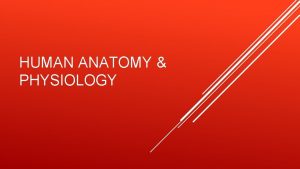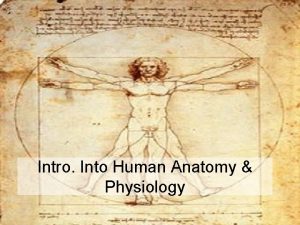Chapter 1 Foundations of Human Anatomy and Physiology










- Slides: 10

Chapter 1: Foundations of Human Anatomy and Physiology Lesson 1. 1 The Language of Anatomy and Physiology

Introducing Anatomy and Physiology Human anatomy and physiology involve the study of the form and function of the human body. In this chapter you will learn some of the important, specialized terminology essential for the study of anatomy and physiology. You will also learn the basic, underlying physiological processes essential for life.

Introducing Anatomy and Physiology Human anatomy Identifies the parts of the human body gross human anatomy microscopic human anatomy Human physiology How the parts of the human body function p. H Ca+ & K+

Describing the Human Body - Planes To describe the human body and its movements, we imagine that there are three planes, or flat surfaces, passing through the center of the body We use these planes to help describe motions of the body and the body segments when they are aligned with the direction of one of these planes.

Describing the Human Body - Planes Sagittal divides the body into right and left portions forward and backward motions of the body are said to be sagittal plane movements. Sagittal plane movements Frontal divides the body into front and back portions sideways movements considered to be frontal plane movements Frontal Plane movements

Describing the Human Body - Planes Transverse divides the body into top and bottom portions rotational movements are called transverse plane movements Transverse Plane movements

Common Directional Terms

Body Cavities Inside the human body are a number of open chambers called cavities that hold the internal organs of the body. dorsal (posterior) cavities Cranial cavity Spinal cavity ventral (anterior) cavities Thoracic cavity Abdominopelvic cavity Abdominal cavity Pelvic cavity

Body Cavities The body also includes several small cavities, including the oral cavity nasal cavity orbital cavities middle ear cavities

Review and Assessment Fill in the blanks with: diaphragm, transverse, thoracic, abdominopelvic, or sagittal. thoracic 1. The heart is located in the ________ cavity. diaphragm 2. The ________ separates the thoracic and abdominal cavities. 3. Divides the body into top and bottom portions ________. transverse
 Aohs foundations of anatomy and physiology 1
Aohs foundations of anatomy and physiology 1 Aohs foundations of anatomy and physiology 2
Aohs foundations of anatomy and physiology 2 Aohs foundations of anatomy and physiology 1
Aohs foundations of anatomy and physiology 1 Aohs foundations of anatomy and physiology 1
Aohs foundations of anatomy and physiology 1 Aohs foundations of anatomy and physiology 1
Aohs foundations of anatomy and physiology 1 Aohs foundations of anatomy and physiology 1
Aohs foundations of anatomy and physiology 1 Waistline
Waistline Medial lateral distal proximal
Medial lateral distal proximal Chapter 2 human reproductive anatomy and physiology
Chapter 2 human reproductive anatomy and physiology Human anatomy and physiology seventh edition marieb
Human anatomy and physiology seventh edition marieb Holes essential of human anatomy and physiology
Holes essential of human anatomy and physiology



















